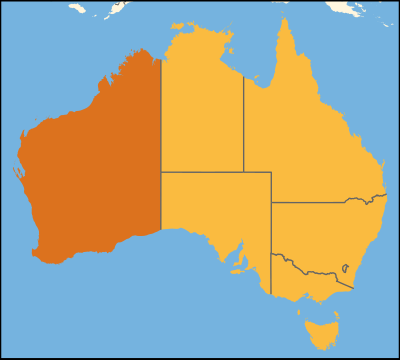
Search
Copper mining in Western Australia

Copper mining in Western Australia is relatively minor on a world scale, accounting for less than one percent of the world's production in 2021–22.
As of 2022, is the sixth most-valuable commodity in the state. It reached its highest-ever sales value in 2021–22 at almost A$2 billion and experienced a growth in production again after having experienced the lowest level in over a decade in the previous year.
Mining for copper in Western Australia is either carried out in designated copper mines, like the Golden Grove mine, the DeGrussa mine and the Jaguar mine and as a by-product, from the Nova and Savannah Mine, nickel mines, and the Boddington gold mine.
Copper production in Western Australia has fluctuated somewhat but nevertheless grown considerably. In 1990–91, the state produced 14,980 tonnes of copper, a figure that had grown ten-fold by 2010 and reached a peak of 211,186 in 2014. Similarly, the value of the industry has grown from A$23.9 million in 1990–91 to almost A$2 billion in 2021–22.
History
The origins of commercial copper mining in Western Australia date back to 1842, when a copper deposit was discovered at Wanerenooka, near the present-day Northampton. In the late 1890s and early 1900s there were small finds such as the Whim Creek copper mine in the Pilbara, and the Kimberley region.
Historical copper mining locations in Western Australia included many mines extracting other minerals at the same operation, where copper tonnage recovered was small. In the early twentieth century, most operations were small, and lasted a short duration. Northampton had copper mining as early as the 1860s, through to the 1890s.
Post-Second World War operations are the Elverdton Mine, near Ravensthorpe, which operated between 1956 and 1972, and the Thaduna Mine, near Wiluna, which was active intermittently from 1955 to 1971. In 1960, the leading copper mine in Western Australia was the Copper Hills Mine, located in the Pilbara and operational until 1963, with mining also carried out at Elverdton, Thaduna and the Kumarina Mine, the later deposit having been discovered before the First World War and mined intermittently until 1973.
By the late 1970s, copper was only mined as a by-product in nickel mines in Western Australia, with between 1,500 and 1,700 tonnes mined annually and a production value of around A$2 million.
Newer operations are the Teutonic Bore Mine, located near the Jaguar Mine, which operated from 1980 to 1985, owned by the Seltrust Mining Corporation. Teutonic Bore, upon opening, had a daily capacity to treat 1,000 tonnes of ore, and an annual capacity of 300,000 tonnes. Apart from copper, the mine also produced silver and zinc.
More prominent and longer-running was the Nifty copper mine, which operated from 1993 to 2019, while the Horseshoe Lights Mine, a combined gold and copper mine, operated from the late 1980s to 1994.
Historical production in Western Australia has been limited. In the early 1980s, Teutonic Bore was the only copper mine in the state, producing less than 3,500 tonnes of copper at a value of between A$3 and 4 million just before its closure. By the early 1990s, copper mining in Western Australia produced around 12,000 tonnes annually at a value of A$20 million from three locations, the Golden Grove and Telfer Mines and Kambalda.
Current mining operations
The following companies operated copper mines in Western Australia in 2022–23, according to the Department of Mines, Industry Regulation and Safety. To qualify for the department's official list of principal mining projects an operation has to either had mineral sales valued at more than $5 million, or, for operations where such figures are not reported, had a minimum of 50 employees:
Export
In 2021–22, over seventy percent of the state's copper production went to South Korea (27 percent), the Philippines (24 percent) and Japan (22 percent). Germany and Finland followed next in this list with nine and five percent each respectively.
Environmental issues
In 2019, the owners of the Whim Creek copper mine were handed an Environmental Protection Notice by the Department of Water and Environmental Regulation because of seepage of heavy metals from the mine into the Balla Balla River, considered a serious pollution risk. While in care and maintenance and with no active mining, Black Rock Minerals re-processed existing stockpiles through a small process plant and heap leach. Copper levels of 3.5 milligrams per litre were recorded in the local drinking water, well above the permitted level of 0.002 milligrams per litre. The small scale re-processing at Whim Creek eventually ceased in October 2019.
Statistics
Annual statistics for the Western Australian copper mining industry. Figures are for financial year, which, in Australia, runs from 1 July to 30 June. Employment figures are for the base metal mining industry overall:
Notes
References
Text submitted to CC-BY-SA license. Source: Copper mining in Western Australia by Wikipedia (Historical)
Owlapps.net - since 2012 - Les chouettes applications du hibou


